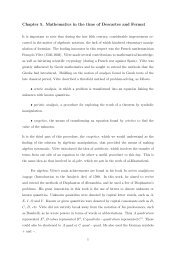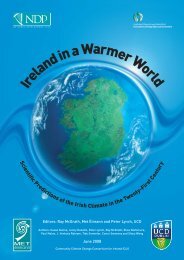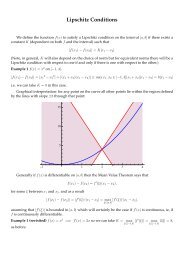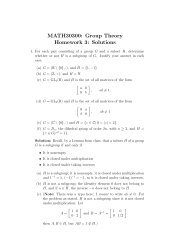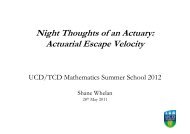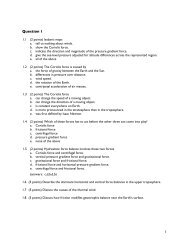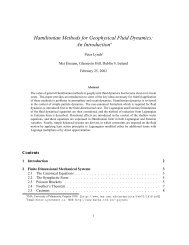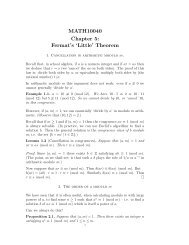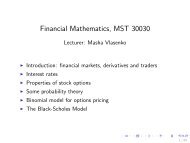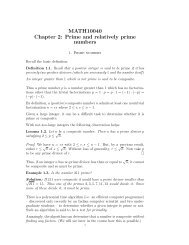MATH10040: Numbers and Functions Homework 1: Solutions
MATH10040: Numbers and Functions Homework 1: Solutions
MATH10040: Numbers and Functions Homework 1: Solutions
Create successful ePaper yourself
Turn your PDF publications into a flip-book with our unique Google optimized e-Paper software.
which is visibly true.Suppose the statement is true for n. Then(1 − 1 )· · ·(1 − 1 ) ()1· 1 −4 n 2 (n + 1) 2= n + 12nwhich is the statement for n + 1.(1 −= n + 12n ·(n + 1) 2 − 1= (n + 1)2 − 1(n + 1) 2 2n(n + 1)= n2 + 2n2n(n + 1)=n + 22(n + 1))1(n + 1) 28. Let p 1 = 2, p 2 = 3, p 3 = 5, p 4 = 7, . . . be the sequence of primes.What is p 13 ? Prove that p n ≥ 2n + 15 for all n ≥ 13.Solution: We prove the statement by induction on n ≥ 13.p 13 = 41 = 2 · 13 + 15. So the statement is true for 13.Suppose now that the statement is true for some n ≥ 13. Thenp n+1 ≥ p n + 2 (why?) <strong>and</strong> p n ≥ 2n + 15 by our inductive hypothesis.Thus p n+1 ≥ (2n + 15) + 2 = 2(n + 1) + 15 as required.9. Explain carefully what is wrong with following argument:Proposition Everybody has the same number of hairs.Proof: We’ll prove this by induction on n, the number of people.If n = 0 or 1, the statement is clearly true.Assume the statement is true for any n people, <strong>and</strong> suppose there isa group of n + 1 people. Remove one person from the group. By ourinductive hypothesis, the remaining n all have the same number ofhairs. Remove a different person. The remaining n people all havethe same number of hairs. Therefore the first person has the samenumber of hairs as all the rest, <strong>and</strong> hence all n + 1 have the samenumber of hairs.Solution: The inductive step in the argument as given fails whenn = 1: In this case n + 1 = 2 <strong>and</strong> when we remove a ‘different person’only the first person remains <strong>and</strong> there is no ‘all the rest’.10. Prove or disprove the following statement: For all natural numbers n,n 2 − n + 41 is a prime number.Solution: The statement is false: taking n = 41, 41 2 − 41 + 41 = 41 2is not prime (it has factors 1, 41 <strong>and</strong> 41 2 ).(by our inductive hyp.)




